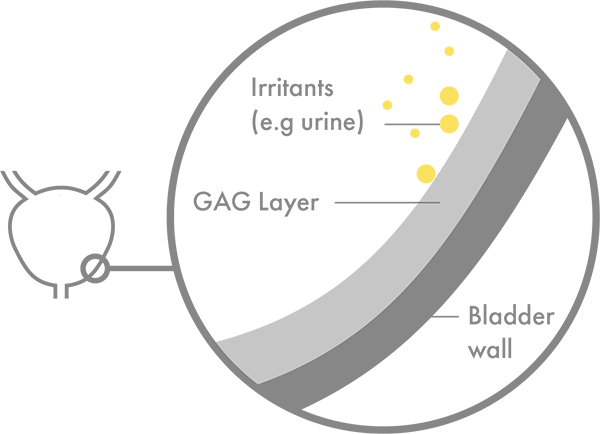The GAG layer and chronic cystitis
- Early repair of the GAG layer by Hyaluronic acid might avoid the chronic evolution of bladder inflammation.
- The restoration of the GAG layer is a main aim of therapy for the treatment of chronic cystitis and PBS/IC.1

Normal functional bladder

Damage to GAG layer

Bladder with GAG Replenisher
Bladder epithelium (BE) is coated by a thick layer of glycosaminoglycans (GAGs). These act as a non-specific anti-adherence factor and a non-specific defence mechanism against infection and irritants found in urine (e.g. urea and potassium). Strong evidence that different chronic inflammatory bladder diseases, such as recurrent urinary tract infection (UTI), chemical or radiation cystitis, and painful bladder syndrome (PBS)/interstitial cystitis (IC) can be pathophysiologically linked in the first step of the disease to the loss of the GAG’s mucous layer independently of the original cause of the inflammatory process.2
Sodium Hyaluronate – clinical efficacy
Intravesical Sodium Hyaluronate can be used with minimal side effects and good compliance in patients with PBS and recurrent UTIs3. Patients received 40mg intravesical HA and held for at least 30 minutes. Instillation was repeated weekly for 4 weeks, and then monthly for an average of 9 instillations completed.
Over a 14-month follow-up period, patients with painful bladder syndrome (PBS) showed statistically significant improvements in:
- Bladder pain
- Urgency
- Nocturia
- Quality of life
Over a 21 month follow-up period, patients with recurrent UTIs showed statistically significant improvements in:
- Bladder pain
- Day time frequency
- Quality of life
75% of the PBS patients responded completely to treatment with HA and required no further treatment.
References
- Damiano and Cicione 2011.
- lavazzo, et al. 2007.
- Raymond, et al. 2012.

© Solatum 2019